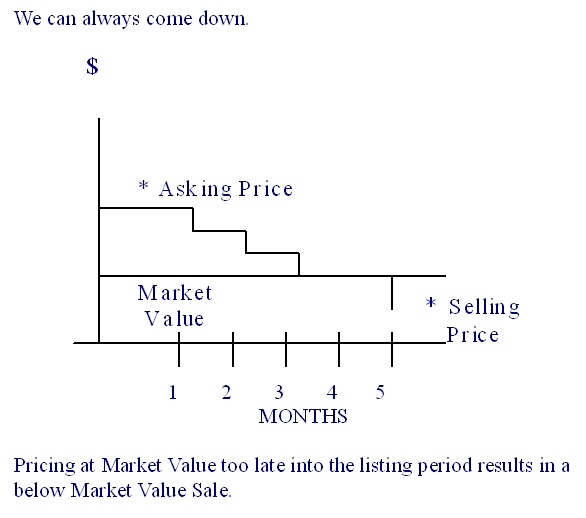The timing of my three most recent blog post is obvious. Aside from the inventory that is left over from 2012, the most number of new homes will be listed this time of year. Thus, heeding our advice now will render our perspective regarding price reductions, later in the year, irrelevant. Your property will already be closed.
Below, I use a third and final graphic from David Knox for home sellers who would like to avoid selling their home below market value – which is basically all of us.
The Question
One of the first questions that a buyer will ask upon entering a home is, “How long has this house been on the market?”
The graph above depicts a scenario that is likely to take place when the seller’s mindset is one that Realtors experience so often, “We can always come down.” Yes you can – at your own peril.
The consequences to this mindset are usually very unattractive. As one can see in the graphic, for reasons explained in yesterday’s blog post, the seller will eventually need to lower the price. Lowering the price is not a commentary on market value – an unknown at this point. A price adjustment is the only truly effective way by which to bring a greater number of qualified buyers into the home.
One May Not Be Enough
A good rule of thumb regarding price adjustments is to lower the price 5% when the showings are steady but there are no bonafide offers. If the number of showings is anemic, then a 10% adjustment is prudent. This creates a further conundrum, however. Many sellers decide to compromise and adjust 5% or less even when the showings have stopped. Unfortunately, that merely portends to create a situation down the road when again there is a dearth of showings, and another 10% adjustment is the likely remedy. Hence, the total adjustment is at least 15%, and that’s before negotiations, if in fact the seller finds a buyer before adjusting the price again.
The Consequences
The result is a home that has become shop worn and the following buyer reactions, among others:
- An unsettling feeling and wondering “Why hasn’t this house sold, is there something wrong with it.”
- “If nothing is wrong with it, then it must be overpriced.”
Once an offer is procured, the seller is now operating from a position of weakness and the home sells below market value, or what the market value would have been if it were priced properly from the beginning.
What other reactions have you experienced from buyers who were interested in a home with a long market time?
How do you, as the listing agent, attempt to overcome their concerns?






